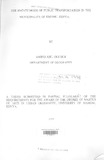| dc.description.abstract | This study has examined the nature of urban public transport
in the MoK as it relates to matatu transport in the (MoK). It
begins by describing the growth and origin of the MoK's public
transport system by illustrating how the present role and
prospects of public transport system shaped by the mobility and
growth in urban population, territorial expansions and the
institutional policy structures. Urban transport plays a vital
role in the economy of Kenya particularly in the major urban
centres which generate a major share of the gross domestic
product (GDP). The transport needs of urban workers are most
acute in these centres amongst which is the MoK, t he third
largest urban centre in Kenya.
Matatus are an intermediate form of transportation. They
are also known as para-transits (Fouracre and Maunder, 1979) The
para-transits are a prevalent mode of urban public transport not
only in the MoK but also in Urban Centres of the Less developed
countries (LDCs).
The objectives of this study were, to examine the role and
future prospects of matatu transport in the MoK, to examine how
the operational and organizational characteristics of matatus
contribute to the efficiency and reliability of urban transport,
to analyze how the private sector provides and controls the
matatu transport to achieve urban transport objectives, to
examine the nature of employment provided by matatu transport and
whether it contributes in solving the problem of urban
unemployment and finally, to examine the constraints affecting
urban transport in the MoK and suggest some solutions. The study advanced various hypotheses. The first hypothesis
was; There is no significant relationship between the number of
used and newly acquired vehicles operated as matatus and the
number of operators who have acquired credit facilities hence the
large number of low quality matatus in the MoK. Secondly, in the
employment offered by ma tatus there is no signif icant
relationship between the level of education of the operators and
their income because the matatu sector like other urban informal
sectors is an open one where skill may be more important thap
formal education in determining earnings. Thirdly, there is no
significant difference between the number of matatus operating
to the low income residential zones and those operating to the
high income residential zones. The research methodology used in
this study employed interviews and questionnaires in the
collection of data. Sampling techniques were used to select the
respondents for interviews. Qualitative analysis such· as the
measures of central tendencies, frequency distribution tables and
histograms and, analytical techniques such as the Simple Linear
Regression Analysis, the T-statistic and the Chi-square statistic
were used in testing the hypotheses of the study. The personal
computer (PC) was used in all these procedures. The theoretical
framework of this study is based on urban transportation system
and the interacting facilities. The model is incoiporated in
this study to project and evaluate the level of service of the
matatu transport as it relates to the future urban growth and
travel demands.
The study found out that urban public transport in .the MoK
is inefficient and inadequate in the quality and quantity of service offered. The study found out that urban publi~
transportation in the MoK is dominated by the matatus. Matatu
transport was found to play a significant role ln meeting urban
transport demands. The matatus were found to be profitable to
the owners and also offered a wide array of employment to young
urban migrants. The private sector was found to play an
important role in the provision and control of matatu transport
although their primary goal is to make profit. The major
problems that plague matatu transport and urban public transport
in' general were found to be i rapidly increasing population,
inadequate maintenance of roads and vehicles, low quality and
quantity of operating fleet, lack of termini due to inadequate
land, unlimited competition for road space with non-motorised
transport and imprecise policy framework.
This study recommends that inorder to improve the quality
of urban transport in the MoK, the urban planners should place
suitable factors both in the physical and social envirnment such
as improvement and regular repair of roads, improvement of road
safety through use of traffic control devices, construction of
primary access roads to improve access to the low income
residential areas and upgrading of matatu termini and stops. The
impact of urban transport should be felt in both policy and
physical terms. | en |

